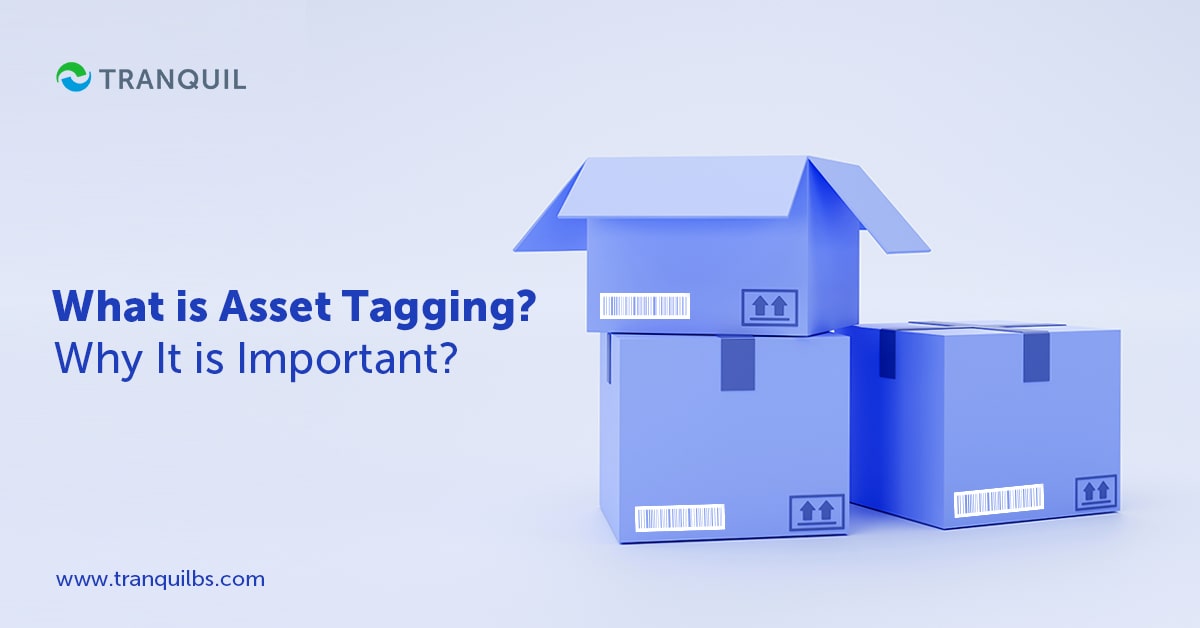
Asset tagging is a crucial activity for any business that relies heavily on assets for revenue generation.
It helps employees to know where inventory, machinery, vehicles, and equipment are at any given time, using tags and labels like RFID tags, GPS trackers, and barcodes.
Savvy businesses can make use of innovative tracking technology and cloud-based tools to minimize the chances of assets being stolen, getting lost, or misplaced.
Tech can also help in enhancing reliability, improving maintenance, and exercising greater control.
A wide range of industries from retail to healthcare to manufacturing can benefit immensely by tagging assets critical to operations.

Attaching tags or labels to assets for easy identification of individual assets is called asset tagging.
Asset tags also help in tracking data – from location in real time to history of maintenance.
Both fixed and moveable assets can be tagged; it is especially useful when moveable assets are located in numerous locations and warehouses.
It gives a comprehensive view of the assets a business owns.
Asset tagging, used in combination with technology like asset management software allows you to a great deal with regard to asset tracking data.
The global market of asset tracking in 2025 is expected to cross $35 billion; this is making companies aware of the necessity and benefits of tracking assets for their operations.
Asset tagging allows you to collect all sorts of data and store it in a digital register.
The information includes:
Asset-intensive businesses have been using digital tools to track assets for some time now.
It is very important to make sure that the correct tags are selected to gather data on the physical assets in an organization.
Remember that each type of tag or label is different, and capable of gathering different types of data.
When you tag mission-critical assets, you can make sure that you:
ALSO READ: ERP software in Warehouse & Fixed Asset Management

Regardless of the type of industry you belong to or what size your business is, it is essential that you are able to tag and track your assets constantly.
It helps you in innumerable ways, one of them which is knowing how many assets your business has.
Let’s look at the chief benefits of tagging assets.
When your business is one that has several moveable assets located in various sites, it can take up a great deal of time to search for a particular asset.
However, if that asset has been tagged, every single asset can be recognized and found immediately.
You should bear in mind that you need to use tags like GPS trackers and RFID tags that have inbuilt real-time capabilities in order to locate your assets swiftly.
The healthcare industry is heavily dependent on proper time management, as even the slightest delay can prove to be fatal.
Asset tagging can help healthcare employees to find medical equipment in a very short time.
In the absence of automated tracking process, healthcare professionals waste thousands of hours a month to search for and find the required equipment.
ALSO READ: Inventory Management Problems and Solutions
Perhaps the biggest advantage in asset tagging is being able to know where a specific asset is at any given time.
Ready availability of such information in an asset register helps businesses minimize the possibility of losing assets that are essential for revenue generation.
These assets need not only be machinery and equipment, but also accessories, spare parts, inventory, tools, and so on.
When assets are under digital watch, the process of tagging assets can help in bringing down the costs that occur when you lose equipment or it gets stolen.
In the construction industry, inadequate asset visibility causes heavy financial losses.
Asset management software is a web-based solution that helps to record movement of assets and provides updated data; it also enables tracking of assets.
By tagging assets, it ensures that there is no data redundancy and that data is well-defined and current.
ALSO READ: What is Negative Inventory?
When you implement a cloud-based system, you get scalability; that is, you can easily upgrade the database as your business grows.
With a reliable asset tracking system, you can easily identify the criteria for demand and disposal, and get the organization ready to grow and expand.

The process of tagging assets is pretty simple, but it is important to get it right.
Let us take a look at the steps involved:
Each asset must be allocated a unique identification number once they have been purchased, and they type and category of the asset have been defined.
As the name suggests, the identification numbers are all different and unique, and are used to be able to easily identify each individual asset, as distinct from one another in an asset tracking system.
Unique identification numbers help managers and departments to account for assets, maintain, and reorder them as well.
ALSO READ: What is Stock Adjustment and Stock Transfer?
You can choose from among many options of tags. However, it is important to understand that there are varying characteristics for each asset tag; ergo, what is suitable for one asset, need not necessarily be apt for another.
Businesses have to decide the basis of prioritizing tags, depending on factors like how durable and secure they are, for instance.
These are the tags you can choose for your assets:
You have to include the precise data that matches the specific asset when you assign tags.
In this manner, you can build a detailed profile for each asset that you will be able to access through the asset tagging solution.
The asset data for each asset includes the following:
ALSO READ: Latest Procurement Trends
After identifying your valuable equipment and creating a unique profile, you can start to tag your organization’s assets.
To do this, you may need to use mechanical attachments or adhesive methods which are pressure-sensitive.
Normally, labels used to for tracking assets are made to be resilient and durable, and are usually available in a wide variety of materials.
Take the example of foil labels; these are often used indoors as well as outdoors for machines and IT equipment.
The graphics are sealed under the label’s upper layer, making them impervious to harsh chemicals, rough use, and severe environments.
If you have expensive and valuable assets, you need to use labels that are tamper-proof, as they are ideal to prevent people from stealing them.
This is because they easily show that they have been interfered with.
Like, the labels may break apart or leave marks behind, or reveal words like VOID or Unauthorized Access, when someone tries to peel them.
Polyester is another material used for labels.
It is used for assets like office furniture.
Polyester labels are those with translucent film that protects the label from liquids like spilt water, beverages, and fluids used for cleaning and disinfecting.
ALSO READ: Challenges Facing Purchasing and Supply Management

There are several types of tags and labels you can use to create an asset tagging system, and each with its own advantages and disadvantages.
Radio Frequency Identification or RFID tags have been in use for decades; in recent times, department store chain Walmart started tracking consumer assets with RFID tags in 2004.
From that time onwards, the technology was adopted massively by retail giants primarily, though it found use in other industries as well.
RFID tags are available in varying forms with different frequencies attached to them.
Durable RFID tags, passive tags, and active tags are the most popular RFID tags used for asset.
These tags have a long-range and are capable of reading data accurately, allowing businesses to leverage asset-tracking systems.
FRID tech helps in boosting stock accuracy, monitoring condition of products that may spoil in transit – like cosmetics, and so on.
ALSO READ: Ways to Improve the Procurement Process
In 1974, the first consumer barcode was scanned, and since then, barcode labels have been used to tag assets and products.
These labels are inexpensive and easily available, making them very popular in businesses that stock innumerable assets in warehouses, store racks, and so on.
Barcodes consist of vertical bars of varying thickness and spaces that stand for specific alphabets and numbers.
Barcodes can be scanned by smartphones, handheld scanners, or other compatible readers.
QR are two-dimensional barcodes as opposed to simple barcodes which are only one-dimensional.
It is able to contain detailed information about the product which carries that label.
ALSO READ: Debit Note vs Credit Note
GPS trackers communicate with satellites, triangulate exact location, thus delivering precise location data in real-time.
They are perfect for tracking vehicles, machinery, and other large moveable assets.
GPS systems are ideal for outdoor tracking, and not suited for indoor tracking; they are also quite expensive.
Transport companies, logistics, and fleet management companies use GPS tracking very effectively to locate their vehicles or assets in transit.
They are also sometimes used by large corporations who store assets in mammoth warehouses.
Near Field Communication tags are a part of RFID technology, with the main difference being that NFC tags enable two-way communication.
The data transfer takes place between tags and electronic devices.
NFC tags are capable of storing data in different formats, and up to 4 KB.
They are ideal for asset tagging operations because they have codes that can be identified uniquely.
NFC systems are usually cloud-based, allowing users to access data regardless of where they are and whenever they need it.
NFC tags are attached to assets directly.
On return of assets after use, these tags transmit accurate, real-time information on its location and use through the asset tracking system.
The reason for this is that NFC tags contain high-speed processors, are more accurate and secure, and thus ideal for asset management.
ALSO READ: What is Backordering?
Asset tagging is absolutely necessary if your business needs many assets for smooth and successful operations. It not only helps in tracking assets, but also helps safeguard assets against loss and theft. However, you also need a robust asset management software to be able to properly track and manage your assets. Tranquil ERP has a feature-packed asset management module that can bring several benefits to your business. Do Schedule a FREE demo to know more.